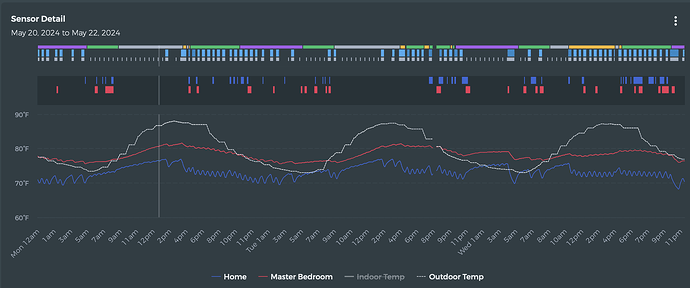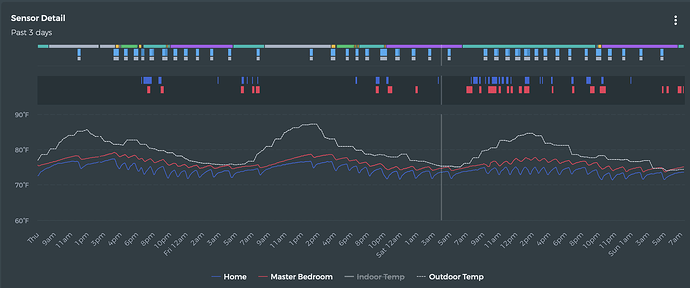This isn't directly Hubitat-related, but I think that HVAC balancing issues are not uncommon, so I hope the approach described here might be useful to someone else.
I moved about 8 months ago into an older house that was built in 1969. This is a 2600 sq ft two-storey house with three bedrooms and a small, largely inaccessible, attic upstairs. The downstairs is mostly open (dining/kitchen/living), along with an office and a bedroom.
The house was built without central air. The house was retrofitted with central air sometime in the late '70s or early '80s. I'm guessing that limited amount of attic space led to a design decision to have a single system to condition both the upstairs and downstairs.
The pre-purchase inspection did note that there was a significant 12-15 degree imbalance between the upstairs and downstairs and very little air was coming out of the registers upstairs. Everything else about the house was acceptable, and I planned on replacing the entire HVAC system, so I wasn't terribly concerned about this. A couple weeks after closing, the owner of the HVAC company I use was available and came out to quote me a new system. He noticed a few difficult to overcome issues, including - the plenum was walled off, so my initial plan of installing a diverter in the plenum or a damper in the main duct for the downstairs was not easy to implement without opening up two walls.
He felt that while it would not be an ideal solution, he could replace all the registers downstairs with registers that had adjustable opposed blades, and after adjusting them, more air would be pushed to the registers upstairs. And then if I had the thermostat circulate air for 10 minutes an hour, I might approach a 5 degree difference between upstairs and downstairs. While not ideal, this was inexpensive to try, so we went ahead and did it. He also said that in place of remodeling, if the temperature imbalance was still too high, he could install a minisplit with 3 head-units for the upstairs.
The adjustable registers did help somewhat - here's what the beestat profile looked like:
It reduced the 12-15 degree imbalance to an 8-10 degree imbalance. Which still meant coming home to a bedroom at 80F, while the downstairs was at 72F. In the profile above, the thermostat (downstairs) sensor is called "Home", and the sensor upstairs is called "Master Bedroom". The little white dashes indicate when the air-handler fan is running, light blue is stage 1 cooling, and dark blue is stage 2 cooling.
Obviously not a good solution. Around May 20th, I had my semi-annual HVAC service, and the tech that came was a skinny young dude who could fit anywhere. So I asked him to see if the main 12" duct going upstairs had collapsed anywhere, and he couldn't find a spot. Then I asked him if he could find a good spot where that duct could be cut to add an in-duct blower. Which he did.
There are 6 registers downstairs and 4 registers upstairs. Using a cheap anemometer from Amazon, I measured the air speed in ft/min at all the registers and converted it to cfm (area x ft/min). The downstairs registers were pushing air out at about 450 cfm. The upstairs registers were pushing air out at about 100 cfm. So I figured that putting in a 1200 cfm in-duct blower should "balance" the system assuming 100% efficiency in distribution. So I bought a 1200 cfm blower and then wired it using a current sensor switch and relay to go on/off in synchrony with the main HVAC blower. I did all the wiring, but paid the skinny HVAC technician to cut out a segment of 12" duct, and replace it with a 12-to-10 reducer at each end, and then two segments of 10" duct connecting the new blower.
Here's the end result:
It worked out really well. The average cfm downstairs is about 400, and average cfm upstairs is about 450. There is a 0.5-3 degree difference between upstairs and downstairs, with an average around 1.7 degree difference. The profiles shows several other desirable changes. Notice that the temperature upstairs (red line) now fluctuates in synchrony with the temperature sensed downstairs. That wasn't happening before. I no longer need to run the HVAC blower periodically, which saves some energy. The A/C is running less frequently and for longer runs. Previously it ran almost entirely in stage 1. Stage 2 is used about 20-30% of the time now. Most importantly, it is equally comfortable upstairs and downstairs. And I didn't have to install a minisplit or window units upstairs.
In terms of energy consumption, the in-duct fan pulls about 240 watts while it is running. It is rated to pull 228 watts - I'm getting the 240 number based on readings from a Sense home energy monitor.
Happy to provide more details on the fan, the relay and the current sensor to anyone who is interested. Materials ran about $450-500. Labor was $200.



